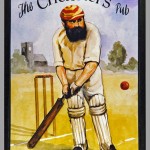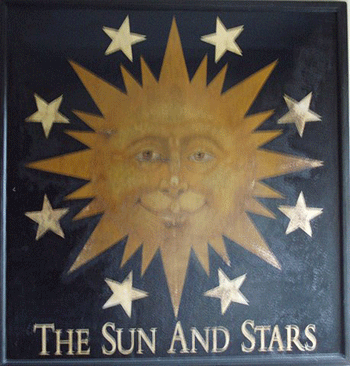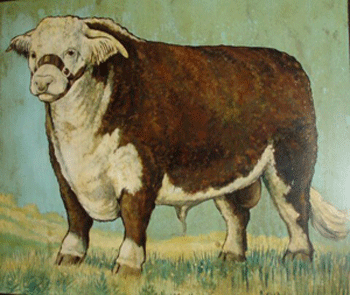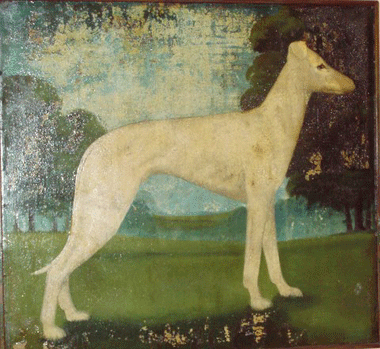There is recent interest amongst dealers and collectors in the few surviving pictorial pub signs. The best examples of these are competently painted traditional subjects which make unusual, attractive and economic decor, with the added interest of a historical name or image stretching back a couple of thousand years. Although older signs can still be found most of the visible images date from the middle of the last century, commonly having been repainted several times, directly over earlier versions of the same picture. For example – Nine Elms, Elephant and Castle, The Angel etc.
Of course all trade signs have ancient origins. The necessity of displaying a symbol to advertise goods, a craft or profession, must be as old as trade itself. Until recent times most people could not read but a picture was easily understood, even by a foreign trader. Long before the earliest towns were established, itinerant merchants would have displayed some emblem of the goods or services they offered, typically attached to a tall staff.
In Ancient Rome the shop sign was well established. There is a carving on an inn in Pompeii of two brewers shouldering a pole from which is slung a large barrel. This exact image can still be seen today on at least one Oxfordshire pub called The Two Brewers. However the carved stone phallus over the doorway of a Pompeii brothel remains to this day a lone example, advertising that other ancient profession.
In Roman Britain as elsewhere, the sale of liquor whether from a roadside stall or permanent brew house, was generally indicated with a display of vine leaves or grapes – real, painted or carved – atop a pole, and the Bunch of Grapes is still with us, as are other pre-Christian names like The Green Man, Sun etc. By medieval times the signs of hostelries, inns and public houses were open to all sorts of influences and had become much more varied than those of other businesses. After all, what can a locksmith display but a lock or a key, or the hatter, a hat?
The church was a major supplier of refreshments to travellers and monasteries all brewed their own beer and offered accommodation. Pubs named The Golden Key, Adam and Eve, Pilgrims’ Rest and the moralistic The First and Last (an improvement on the earlier and depressing ‘Cradle and Coffin’), and the Mitre date from these early years of Christianity in Britain and are still around today. Later, knights and their supporters journeying to the various crusades, gave us The Saracen’s Head, and brought heraldic influences into the mix. Most of the Red Lion, Boar’s Head, Swan, White Hart and such motifs come from noble crusader families’ coats of arms. Aristocratic landowners too gave their names (with arms) to appropriately situated inns. Pubs in towns and cities often were associated with urban occupations, crafts or guilds and were signed accordingly; Goldbeater’s Arms, Porter’s Butt (i.e. barrel), Lamplighter etc, but curious combinations arose when, for example an established business moved into premises formerly occupied by another whose sign was still a local landmark (and not easily dispensed with). So names like The Sun and Moors Head, The Queen’s Head and Artichoke (still in Albany Street), and Blue Peruke and Star came about. The Devil and Bag O’Nails actually belongs in the religious category ( the Devil and Baccanals) as does The Goat and Compasses (God Encompasseth Us). Some areas of London take their name from the original (village) pubs; Gospel Oak, Nine Elms, The Angel etc. Royal symbols; Crown, Crown and Sceptre, King’s and Queen’s Heads (and royal Arms), were more urban than rural, but widely distributed
Country pub names recognised rural activities; Wheatsheaf, Barley Mow, Drovers’ Arms, Woolpack, Plough (there was a Plough and Ship, an odd combination now gone), and of course lots of Bulls (red, Black and Pied), Horses (White and Black), and Nag’s Heads. In the shires the sporting activities, mainly of the gentry, were commemorated in such pub names as Fox and Hounds, Hare and Hounds, The Talbot, Stag, Pheasant, Huntsman, Dog and Duck and Bird in Hand (Falconry).
Britain’s maritime situation and military adventures have produced the Ship, Anchor, Mermaid, Dolphin, Trafalgar, Nelson etc., and The Gun, Infantryman, Bugle, also Waterloo and many other (victorious) battles, with Admirals and Generals well represented. This rather bloodthirsty roll call is somewhat alleviated by humour (at least for males – the principal drinkers); The Silent Woman (depicted as wearing a scold’s bridle, or actually beheaded), The Load of Mischief (a man carrying a fat rowdy wife), and so forth.
For whatever the historical reasons, Britain is the main repository of this huge variety of drinking establishments with colourful names and signs. In the 17th and 18th centuries signage across the whole of Europe seems to have developed along similar lines and the carvings which hung from the wrought iron brackets outside a Parisian ‘Gantier’, and a London ‘Glover’ would have been very similar. With regard to alcohol, the Latin continentals mostly seemed to have consumed it (mainly as wine) while eating, and didn’t much go in for exclusive drinking, whereas our German cousins with their beer cellars seem mainly to have had very attractive iron and wood signs with little or no pictorial element.






























